Manta
Rays of Mexico's Pacific
Copyright © 2002 Terry Maas, BlueWater Freedivers
(Click on a photo for an
enlargement)
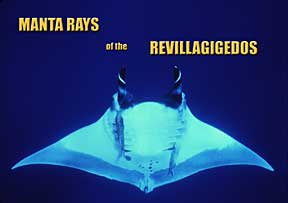
What the giant manta rays do with humans is unique in this world. A
totally wild animal, twice the mass of a horse, seeks out and revels in
human physical contact.
"Here she comes," yells Sherry Shaffer as the big manta
glides up from 60 feet below. The graceful, black winged giant looms ever
larger to within a foot of Sherry’s out-stretched arms. Like Ariel and
Pegasus, the two resume their underwater ballet—a dance they have
rehearsed for hours.
This time, like a fighter plane, the Pacific manta ray descends with
Sherry at a steep downward-angle while she holds her breath. Sherry’s
hands tighten on the tails of the twin remora sucker fish—her finned
reins affixed with superglue on the back of their accommodating host.
Suddenly, the descent angle increases and the jet-black ray transforms
into a bright-white beacon as it flips over in an aerobatic outside loop
40-feet below. Sherry disappears under the bulk of the inverted ray then
appears over-the-falls as her "gentle giant" ascends to
re-deposit her safely at the surface.
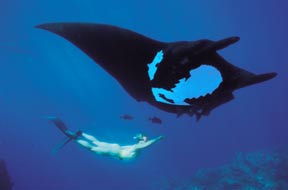
Graceful Sherry plays with a large manta ray
Sherry has been swimming with the manta rays of San Benedicto for
years. She recognizes several individuals by their unique belly markings.
She and others have given them names—Ladyface, Stringfellow, Loopy
and Wizard. There is anecdotal evidence that these mantas recognize people
as well. "More than once, Ladyface has picked me out of a group of
divers and swam directly toward my waving hand," says Sherry. "I
know they are intelligent, I can see it in their large inquisitive eye as
it tracks me when I swim by."
Not all of the human interactions with manta rays are so joyful. A
close friend recently filmed a commercial fishing boat not far from Sherry’s
encounters. The video, punctuated with the racking sobs of her friend,
depicts the butchering of a manta ray with rivulets of blood contrasting
painfully against its black, hacked off wing as the fishermen hoisted it
aboard.
Early superstitious fishermen called them Devilfish. Manta rays often
feed at the surface on small zooplankton and krill funneling them into
their mouths with specialized head fins—cephalic fins—unfurled below
into twin scoops. Sometimes they accidentally swim into anchor ropes or
into hard-hat diver’s air hoses. Since rays have no reverse gear, when
caught they swim forward ever faster. Equally frightened fishermen or
divers likened the fleeing rays to malignant beasts, with black wings sent
from Hell to terrorize them. Fleeing mantas frequently lunge out of the
water landing in a resounding slap—a maneuver that completes the
Devilfish legend. The story goes that the rays would tow a skiff out to
sea then crush the hapless crew by leaping on them.
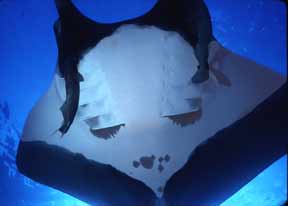
Ladyface
As with most of the ocean’s animals, if we put our entire knowledge
about them into a book, only blank pages would follow the preface. Much of
what we know of the giant manta rays of Baja is a speculative amalgam of
anecdotal behavior and physical science. For example, Sherry’s claim of
intelligence is supported by the physical evidence that mantas have a
larger brain than fish.
A closer look at the ray’s brain, however, reveals that the enlarged
areas represent hearing, feeling and coordination. A more rational
explanation for the enlargement is that these areas assist its host in
finding and eating food.
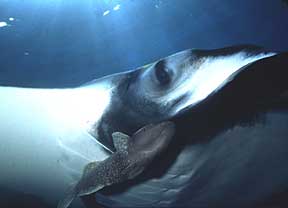
Buddies, two eyes are better than one.
Mantas are not schooling fish. They are generally solitary or form
loose aggregations of 3 to 6 animals. Sometimes they gather in larger
groups of 30 to feed on a concentration of krill. Over and over, they
summersault in tight loops, their white bellies flashing. Some suggest
that the looping is a vortex generator—the hydrodynamic equivalent of a
sheep dog herding millions of krill into a concentrated ball to be rammed
into the gaping manta mouths on their next pass.
Krill are known to frighten into a compact immobile mass by a loud
sound. Could this be why mantas leap and splash—to immobilize the krill?
Behavioral scientists follow up on clues that nature provides. After a
meal of krill, mantas defecate leaving huge bilious clouds in their wake,
their color dependent on the ray’s food source. So dedicated is manta
observer Captain Scott Sundby that he swims into the fecal clouds for
clues about manta feeding habits. "I first note the color," he
says "then I look for undigested skeletons of the manta’s last
meal."
Starting in 1994 for and continuing for five years, Scott made over 130
dives-a-year with the mantas of San Benedicto. Besides studying their
behavior, he records the belly patterns and chevron markings on the ray’s
top to identify individuals. Scott identified one animal, named Stumpy for
its missing cephalic fin. In 30 days Stumpy was sighted at each of the 3
islands of the archipelago, 30 to 60 miles apart.
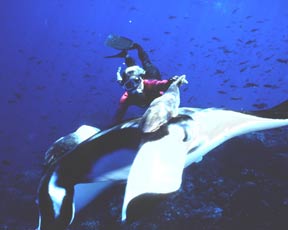
Scott has observed mantas at 200 feet below the surface. Do they go
deeper? Their anatomy suggests they can. Their large brain contains
vascular retes—a series of parallel arteries and veins capable of
mimicking a heat exchanger—the same set up found in other
heat-conserving, deep sea diving animals. However, the retes might simply
help keep the animal’s brain a steady temperature, transferring heat
from the heat-absorbing wings while on the surface and from deeper within
its body when submerged. Recently, Japanese researchers successfully
attached pressure gauges to mantas, which recorded their depth excursions.
During the day, they swam on the surface and down to 150 feet. During the
night, however, they spent most of the time skimming the ocean floor at
600 feet while making only occasional trips to the surface.
With over 100 animals cataloged, the population around San Benedicto is
similar in size to the other two known Pacific manta ray populations,
Hawaii and Yap. Certainly, with a maximum of 400 animals in each
sub-population, commercial fishing for manta rays will not solve the world’s
food problems. Similar to sharks, manta rays have a slow molecular clock—their
mutation rates are low. When the Gulf of Panama closed 3.5 million years
ago, the Gulf of Mexico mantas were separated from their Eastern Pacific
relatives. Recent DNA studies by Texas A & M graduate student Tim
Clark reveals only minor genetic variations among these sub-populations.
His studies suggest that all the mantas of the world are of the same
species.

Clarion angle fish leave the safety of their rock home to clean
parasites from passing mantas.
Manta rays (Manta birostris) are the gentle giants of the ray family
Mobulidae. The largest recorded manta was taken off the coast of India. It
measured 22 feet tip-to-tip and weighed in excess of two tons. We think
these animals live an excess of 30 years based on 3 observations. A baby
manta in Hawaii, observed growing over the last 10 years has not yet
reached sexual maturity. A rule-of-thumb for the manta family is that
these animals live 3 times their age when they reach maturity. Supporting
this evidence is the re-sighting of the same adult mantas at San Benedicto
over 10 years. Since mantas bear only a single live pup, they fit into the
pattern of a long-lived animal.
Next to the independent eyes, the dual cephalic fins provide mantas
with a rich sensory tool for locating food. For streamlined cruising,
these fins corkscrew into neat thin forward-projecting appendages.
Unfurled, they arc below the mouth forming a scoop for feeding and
maneuvering. They funnel small crustaceans and krill into their mouths
where 120 to 130 comb-like teeth filter out dinner. Their long tails lack
a stinging spine at the base like other rays. Clarion idle fish love to
pick at the end of the tail. The tails might aid in balanced swimming,
however, we have seen several mantas with missing or short tails that
appear to function normally.
The sandpaper texture of the ray’s skin offers opportunities for
other species. Captain Sunby once observed a shark dive-bomb a manta. At
the last second, the shark turned and scraped its skin against the manta’s—perhaps
to rid itself of parasites. Constant traveling companions with the mantas
of Baja are the remoras also called disk fish. Generally found in mated
pairs, these opportunistic hitchhikers secure their ride with tiny barbs
on the top of their flat heads, which attach to the manta’s skin like
Velcro. Additionally, the hydrodynamic shape of the remora’s head
creates a force that helps it stick to its host. While they do not wander
far, remoras will leave their manta long enough to grab a quick bite of
passing food—small pelagic crabs.
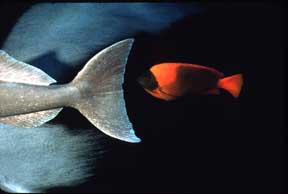
Mantas gather at cleaning stations—shallow prominences on the reef
that shelter cleaner fish. As mantas approach, small wrass and other
cleaner fish pick off parasites and clean debris from their surface
wounds. At San Benedicto, brilliant red clarion idol fish risk the shelter
of the reef and cross the open water gap to waiting mantas. Since the
remora fish tend to concentrate the manta ray’s parasites on their body,
we often observe the clarion idols picking at the bodies and tails of the
remoras as seen in the accompanying photo. (See accompanying photo.)
Mantas form a single-file train over the reef during mating. Twenty
males may chase a single female. When she makes the final selection, she
allows the male(s) to bite onto her long fin tip and slide beneath her for
abdomen-to-abdomen copulation.
Because of the huge increase in interest, divers have flocked to see
the mantas. Sherry no longer touches these magic carpets. A tour boat with
25 eager manta riders is simply too much pressure for even these most
tempting and loveable of beasts. Still, the mantas of San Benedicto love
human interaction. We’ve seen them, day after day, seek us out for rides
and other interactions. The underbelly of the manta is especially
sensitive. We used to swim under a manta and gently place a palm of our
hand just forward of the vent and rub. Enraptured, the mantas simply stop
swimming and sink, pushing us down with their slowly sinking mass.
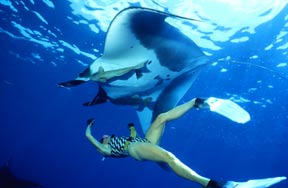
Some mantas are hunted outright; others wind up as by-catch in nets. In
Mexico, their dead value is about 40-cents a pound compared to the $10 to
$20 that shark fins command (another sad story.) The slaughter of manta
rays is senseless especially in light of their relative economic value.
Andrea Tomba of the Cortez Club in La Paz, Mexico considers mantas a
primary attraction drawing divers from around the world. He estimates that
mantas contribute to an average daily income of $3,300-per-day for the 10
local diving tour operators. Sherry, Scott and anyone else who has ever
swam with these gentle giants knows that the value of a manta experience
cannot be calculated in dollars. For many of us, swimming with the
majestic manta ray accounts for an experience of a lifetime.
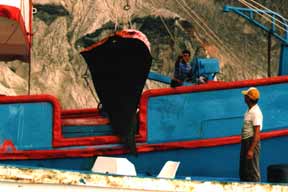
|